Word-building
is one of the main ways of enriching vocabulary. There are four main
ways of word-building in modern English: affixation, composition,
conversion, abbreviation. There are also secondary ways of
word-building: sound interchange, stress interchange, sound
imitation, blends, back formation.
Affixation
Affixation
is one of the most productive ways of word-building throughout the
history of English. It consists in adding an affix to the stem of a
definite part of speech. Affixation is divided into suffixation and
prefixation.
Suffixation.
The
main function of suffixes in Modern English is to form one part of
speech from another, the secondary function is to change the lexical
meaning of the same part of speech. ( e.g. «educate» is a verb,
«educatee» is a noun, and « music» is a noun, «musicdom» is
also a noun) .
There
are different classifications of suffixes :
1.
Part-of-speech classification. Suffixes which can form different
parts of speech are given here :
a)
noun-forming suffixes, such as : -er (criticizer), -dom
(officialdom), -ism (ageism),
b)
adjective-forming suffixes, such as : -able (breathable), less
(symptomless), -ous (prestigious),
c)
verb-forming suffixes, such as -ize (computerize) , -ify (micrify),
d)
adverb-forming suffixes , such as : -ly (singly), -ward (tableward),
e)
numeral-forming suffixes, such as -teen (sixteen), -ty (seventy).
2.
Semantic classification . Suffixes changing the lexical meaning of
the stem can be subdivided into groups, e.g. noun-forming suffixes
can denote:
a)
the agent of the action, e.g. -er (experimenter), -ist (taxist), -ent
(student),
b)
nationality, e.g. -ian (Russian), -ese (Japanese), -ish (English),
c)
collectivity, e.g. -dom (moviedom), -ry (peasantry, -ship
(readership), -ati ( literati),
d)
diminutiveness, e.g. -ie (horsie), -let (booklet), -ling (gooseling),
-ette (kitchenette),
e)
quality, e.g. -ness (copelessness), -ity (answerability).
3.
Lexico-grammatical character of the stem. Suffixes which can be added
to certain groups of stems are subdivided into:
a)
suffixes added to verbal stems, such as : -er (commuter), -ing
(suffering), — able (flyable), -ment (involvement), -ation
(computerization),
b)
suffixes added to noun stems, such as : -less (smogless), ful
(roomful), -ism (adventurism), -ster (pollster), -nik (filmnik), -ish
(childish),
c)
suffixes added to adjective stems, such as : -en (weaken), -ly
(pinkly), -ish (longish), -ness (clannishness).
4.
Origin of suffixes. Here we can point out the following groups:
a)
native (Germanic), such as -er,-ful, -less, -ly.
b)
Romanic, such as : -tion, -ment, -able, -eer.
c)
Greek, such as : -ist, -ism, -ize.
d)
Russian, such as -nik.
5.
Productivity. Here we can point out the following groups:
a)
productive, such as : -er, -ize, —ly, -ness.
b)
semi-productive, such as : -eer, -ette, -ward.
c)
non-productive , such as : -ard (drunkard), -th (length).
Suffixes
can be polysemantic, such as : -er can form nouns with the following
meanings : agent,doer of the action expressed by the stem (speaker),
profession, occupation (teacher), a device, a tool (transmitter).
While speaking about suffixes we should also mention compound
suffixes which are added to the stem at the same time, such as -ably,
-ibly, (terribly, reasonably), -ation (adaptation from adapt).
There
are also disputable cases whether we have a suffix or a root morpheme
in the structure of a word, in such cases we call such morphemes
semi-suffixes, and words with such suffixes can be classified either
as derived words or as compound words, e.g. -gate (Irangate), -burger
(cheeseburger), -aholic (workaholic) etc.
Соседние файлы в предмете [НЕСОРТИРОВАННОЕ]
- #
- #
- #
- #
- #
- #
- #
- #
- #
- #
- #
Lecture 3. Word-building: affixation, conversion, composition, abbreviation. THE WORD-BUILDING SYSTEM OF ENGLISH 1. Word-derivation 2. Affixation 3. Conversion 4. Word-composition 5. Shortening 6. Blending 7. Acronymy 8. Sound interchange 9. Sound imitation 10. Distinctive stress 11. Back-formation Word-formation is a branch of Lexicology which studies the process of building new words, derivative structures and patterns of existing words. Two principle types of wordformation are distinguished: word-derivation and word-composition. It is evident that wordformation proper can deal only with words which can be analyzed both structurally and semantically. Simple words are closely connected with word-formation because they serve as the foundation of derived and compound words. Therefore, words like writer, displease, sugar free, etc. make the subject matter of study in word-formation, but words like to write, to please, atom, free are irrelevant to it. WORD-FORMATION WORD-DERIVATION AFFIXATION WORD-COMPOSITION CONVERSION 1. Word-derivation. Speaking about word-derivation we deal with the derivational structure of words which basic elementary units are derivational bases, derivational affixes and derivational patterns. A derivational base is the part of the word which establishes connection with the lexical unit that motivates the derivative and determines its individual lexical meaning describing the difference between words in one and the same derivative set. For example, the individual lexical meaning of the words singer, writer, teacher which denote active doers of the action is signaled by the lexical meaning of the derivational bases: sing-, write-, teach-. Structurally derivational bases fall into 3 classes: 1. Bases that coincide with morphological stems of different degrees оf complexity, i.e., with words functioning independently in modern English e.g., dutiful, day-dreamer. Bases are functionally and semantically distinct from morphological stems. Functionally the morphological stem is a part of the word which is the starting point for its forms: heart – hearts; it is the part which presents the entire grammatical paradigm. The stem remains unchanged throughout all word-forms; it keeps them together preserving the identity of the word. A derivational base is the starting point for different words (heart – heartless – hearty) and its derivational potential outlines the type and scope of existing words and new creations. Semantically the stem stands for the whole semantic structure of the word; it represents all its lexical meanings. A base represents, as a rule, only one meaning of the source word. 2. Bases that coincide with word-forms, e.g., unsmiling, unknown. The base is usually represented by verbal forms: the present and the past participles. 3. Bases that coincide with word-groups of different degrees of stability, e.g., blue-eyed, empty-handed. Bases of this class allow a rather limited range of collocability, they are most active with derivational affixes in the class of adjectives and nouns (long-fingered, blue-eyed). Derivational affixes are Immediate Constituents of derived words in all parts of speech. Affixation is generally defined as the formation of words by adding derivational affixes to different types of bases. Affixation is subdivided into suffixation and prefixation. In Modern English suffixation is mostly characteristic of nouns and adjectives coining, while prefixation is mostly typical of verb formation. A derivational pattern is a regular meaningful arrangement, a structure that imposes rigid rules on the order and the nature of the derivational base and affixes that may be brought together to make up a word. Derivational patterns are studied with the help of distributional analysis at different levels. Patterns are usually represented in a generalized way in terms of conventional symbols: small letters v, n, a, d which stand for the bases coinciding with the stems of the respective parts of speech: verbs, etc. Derivational patterns may represent derivative structure at different levels of generalization: - at the level of structural types. The patterns of this type are known as structural formulas, all words may be classified into 4 classes: suffixal derivatives (friendship) n + -sf → N, prefixal derivatives (rewrite), conversions (a cut, to parrot) v → N, compound words (musiclover). - at the level of structural patterns. Structural patterns specify the base classes and individual affixes thus indicating the lexical-grammatical and lexical classes of derivatives within certain structural classes of words. The suffixes refer derivatives to specific parts of speech and lexical subsets. V + -er = N (a semantic set of active agents, denoting both animate and inanimate objects - reader, singer); n + -er = N (agents denoting residents or occupations Londoner, gardener). We distinguish a structural semantic derivationa1 pattern. - at the level of structural-semantic patterns. Derivational patterns may specify semantic features of bases and individual meaning of affixes: N + -y = A (nominal bases denoting living beings are collocated with the suffix meaning "resemblance" - birdy, catty; but nominal bases denoting material, parts of the body attract another meaning "considerable amount" - grassy, leggy). The basic ways of forming new words in word-derivation are affixation and conversion. Affixation is the formation of a new word with the help of affixes (heartless, overdo). Conversion is the formation of a new word by bringing a stem of this word into a different paradigm (a fall from to fall). 2. Affixation Affixation is generally defined as the formation of words by adding derivational affixes to different types of bases. Affixation includes suffixation and prefixation. Distinction between suffixal and prefixal derivates is made according to the last stage of derivation, for example, from the point of view of derivational analysis the word unreasonable – un + (reason- + -able) is qualified as a prefixal derivate, while the word discouragement – (dis- + -courage) + -ment is defined as a suffixal derivative. Suffixation is the formation of words with the help of suffixes. Suffixes usually modify the lexical meaning of the base and transfer words to a different part of speech. Suffixes can be classified into different types in accordance with different principles. According to the lexico-grammatical character suffixes may be: deverbal suffixes, e.d., those added to the verbal base (agreement); denominal (endless); deadjectival (widen, brightness). According to the part of speech formed suffixes fall into several groups: noun-forming suffixes (assistance), adjective-forming suffixes (unbearable), numeral-forming suffixes (fourteen), verb-forming suffixes (facilitate), adverb-forming suffixes (quickly, likewise). Semantically suffixes may be monosemantic, e.g. the suffix –ess has only one meaning “female” – goddess, heiress; polysemantic, e.g. the suffix –hood has two meanings “condition or quality” falsehood and “collection or group” brotherhood. According to their generalizing denotational meaning suffixes may fall into several groups: the agent of the action (baker, assistant); collectivity (peasantry); appurtenance (Victorian, Chinese); diminutiveness (booklet). Prefixation is the formation of words with the help of prefixes. Two types of prefixes can be distinguished: 1) those not correlated with any independent word (un-, post-, dis-); 2) those correlated with functional words (prepositions or preposition-like adverbs: out-, up-, under-). Diachronically distinction is made between prefixes of native and foreign origin. Prefixes can be classified according to different principles. According to the lexico-grammatical character of the base prefixes are usually added to, they may be: deverbal prefixes, e.d., those added to the verbal base (overdo); denominal (unbutton); deadjectival (biannual). According to the part of speech formed prefixes fall into several groups: noun-forming prefixes (ex-husband), adjective-forming prefixes (unfair), verb-forming prefixes (dethrone), adverb-forming prefixes (uphill). Semantically prefixes may be monosemantic, e.g. the prefix –ex has only one meaning “former” – ex-boxer; polysemantic, e.g. the prefix –dis has four meanings “not” disadvantage and “removal of” to disbrunch. According to their generalizing denotational meaning prefixes may fall into several groups: negative prefixes – un, non, dis, a, in (ungrateful, nonpolitical, disloyal, amoral, incorrect); reversative prefixes - un, de, dis (untie, decentralize, disconnect); pejorative prefixes – mis, mal, pseudo (mispronounce, maltreat, pseudo-scientific); prefix of repetition (redo), locative prefixes – super, sub, inter, trans (superstructure, subway, intercontinental, transatlantic). 3. Conversion Conversion is a process which allows us to create additional lexical terms out of those that already exist, e.g., to saw, to spy, to snoop, to flirt. This process is not limited to one syllable words, e.g., to bottle, to butter, nor is the process limited to the creation of verbs from nouns, e.g., to up the prices. Converted words are extremely colloquial: "I'll microwave the chicken", "Let's flee our dog", "We will of course quiche and perrier you". Conversion came into being in the early Middle English period as a result of the leveling and further loss of endings. In Modern English conversion is a highly-productive type of word-building. Conversion is a specifically English type of word formation which is determined by its analytical character, by its scarcity of inflections and abundance of mono-and-de-syllabic words in different parts of speech. Conversion is coining new words in a different part of speech and with a different distribution but without adding any derivative elements, so that the original and the converted words are homonyms. Structural Characteristics of Conversion: Mostly monosyllabic words are converted, e.g., to horn, to box, to eye. In Modern English there is a marked tendency to convert polysyllabic words of a complex morphological structure, e.g., to e-mail, to X-ray. Most converted words are verbs which may be formed from different parts of speech from nouns, adjectives, adverbs, interjections. Nouns from verbs - a try, a go, a find, a loss From adjectives - a daily, a periodical From adverbs - up and down From conjunctions - but me no buts From interjection - to encore Semantic Associations / Relations of Conversion: The noun is the name of a tool or implement, the verb denotes an action performed by the tool, e.g., to nail, to pin, to comb, to brush, to pencil; The noun is the name of an animal, the verb denotes an action or aspect of behavior considered typical of this animal, e.g., to monkey, to rat, to dog, to fox; When the noun is the name of a part of a human body, the verb denotes an action performed by it, e.g., to hand, to nose, to eye; When the noun is the name of a profession or occupation, the verb denotes the activity typical of it, e.g., to cook, to maid, to nurse; When the noun is the name of a place, the verb will denote the process of occupying the place or by putting something into it, e.g., to room, to house, to cage; When the word is the name of a container, the verb will denote the act of putting something within the container, e.g., to can, to pocket, to bottle; When the word is the name of a meal, the verb means the process of taking it, e.g., to lunch, to supper, to dine, to wine; If an adjective is converted into a verb, the verb may have a generalized meaning "to be in a state", e.g., to yellow; When nouns are converted from verbs, they denote an act or a process, or the result, e.g., a try, a go, a find, a catch. 4. Word-composition Compound words are words consisting of at least two stems which occur in the language as free forms. Most compounds in English have the primary stress on the first syllable. For example, income tax has the primary stress on the in of income, not on the tax. Compounds have a rather simple, regular set of properties. First, they are binary in structure. They always consist of two or more constituent lexemes. A compound which has three or more constituents must have them in pairs, e.g., washingmachine manufacturer consists of washingmachine and manufacturer, while washingmachine in turn consists of washing and machine. Compound words also usually have a head constituent. By a head constituent we mean one which determines the syntactic properties of the whole lexeme, e.g., the compound lexeme longboat consists of an adjective, long and a noun, boat. The compound lexeme longboat is a noun, and it is а noun because boat is a noun, that is, boat is the head constituent of longboat. Compound words can belong to all the major syntactic categories: • Nouns: signpost, sunlight, bluebird, redwood, swearword, outhouse; • Verbs: window shop, stargaze, outlive, undertake; • Adjectives: ice-cold, hell-bent, undersized; • Prepositions: into, onto, upon. From the morphological point of view compound words are classified according to the structure of immediate constituents: • Compounds consisting of simple stems - heartache, blackbird; • Compounds where at least one of the constituents is a derived stem -chainsmoker, maid-servant, mill-owner, shop-assistant; • Compounds where one of the constituents is a clipped stem - V-day, A-bomb, Xmas, H-bag; • Compounds where one of the constituents is a compound stem - wastes paper basket, postmaster general. Compounds are the commonest among nouns and adjectives. Compound verbs are few in number, as they are mostly the result of conversion, e.g., to blackmail, to honeymoon, to nickname, to safeguard, to whitewash. The 20th century created some more converted verbs, e.g., to weekend, to streamline,, to spotlight. Such converted compounds are particularly common in colloquial speech of American English. Converted verbs can be also the result of backformation. Among the earliest coinages are to backbite, to browbeat, to illtreat, to housekeep. The 20th century gave more examples to hitch-hike, to proof-read, to mass-produce, to vacuumclean. One more structural characteristic of compound words is classification of compounds according to the type of composition. According to this principle two groups can be singled out: words which are formed by a mere juxtaposition without any connecting elements, e.g., classroom, schoolboy, heartbreak, sunshine; composition with a vowel or a consonant placed between the two stems. e.g., salesman, handicraft. Semantically compounds may be idiomatic and non-idiomatic. Compound words may be motivated morphologically and in this case they are non-idiomatic. Sunshine - the meaning here is a mere meaning of the elements of a compound word (the meaning of each component is retained). When the compound word is not motivated morphologically, it is idiomatic. In idiomatic compounds the meaning of each component is either lost or weakened. Idiomatic compounds have a transferred meaning. Chatterbox - is not a box, it is a person who talks a great deal without saying anything important; the combination is used only figuratively. The same metaphorical character is observed in the compound slowcoach - a person who acts and thinks slowly. The components of compounds may have different semantic relations. From this point of view we can roughly classify compounds into endocentric and exocentric. In endocentric compounds the semantic centre is found within the compound and the first element determines the other as in the words filmstar, bedroom, writing-table. Here the semantic centres are star, room, table. These stems serve as a generic name of the object and the determinants film, bed, writing give some specific, additional information about the objects. In exocentric compound there is no semantic centre. It is placed outside the word and can be found only in the course of lexical transformation, e.g., pickpocket - a person who picks pockets of other people, scarecrow an object made to look like a person that a farmer puts in a field to frighten birds. The Criteria of Compounds As English compounds consist of free forms, it's difficult to distinguish them from phrases, because there are no reliable criteria for that. There exist three approaches to distinguish compounds from corresponding phrases: Formal unity implies the unity of spelling solid spelling, e.g., headmaster; with a hyphen, e.g., head-master; with a break between two components, e.g., head master. Different dictionaries and different authors give different spelling variants. Phonic principal of stress Many compounds in English have only one primary stress. All compound nouns are stressed according to this pattern, e.g., ice-cream, ice cream. The rule doesn't hold with adjectives. Compound adjectives are double-stressed, e.g., easy-going, new-born, sky-blue. Stress cannot help to distinguish compounds from phrases because word stress may depend on phrasal stress or upon the syntactic function of a compound. Semantic unity Semantic unity means that a compound word expresses one separate notion and phrases express more than one notion. Notions in their turn can't be measured. That's why it is hard to say whether one or more notions are expressed. The problem of distinguishing between compound words and phrases is still open to discussion. According to the type of bases that form compounds they can be of : 1. compounds proper – they are formed by joining together bases built on the stems or on the ford-forms with or without linking element, e.g., door-step; 2. derivational compounds – by joining affixes to the bases built on the word-groups or by converting the bases built on the word-groups into the other parts of speech, e.g., longlegged → (long legs) + -ed, a turnkey → (to turn key) + conversion. More examples: do-gooder, week-ender, first-nighter, house-keeping, baby-sitting, blue-eyed blond-haired, four-storied. The suffixes refer to both of the stems combined, but not to the final stem only. Such stems as nighter, gooder, eyed do not exist. Compound Neologisms In the last two decades the role of composition in the word-building system of English has increased. In the 60th and 70th composition was not so productive as affixation. In the 80th composition exceeded affixation and comprised 29.5 % of the total number of neologisms in English vocabulary. Among compound neologisms the two-component units prevail. The main patterns of coining the two-component neologisms are Noun stem + Noun stem = Noun; Adjective stem + Noun stem = Noun. There appeared a tendency to coin compound nouns where: The first component is a proper noun, e.g., Kirlian photograph - biological field of humans. The first component is a geographical place, e.g., Afro-rock. The two components are joined with the help of the linking vowel –o- e.g., bacteriophobia, suggestopedia. The number of derivational compounds increases. The main productive suffix to coin such compound is the suffix -er - e.g., baby-boomer, all nighter. Many compound words are formed according to the pattern Participle 2 + Adv = Adjective, e.g., laid-back, spaced-out, switched-off, tapped-out. The examples of verbs formed with the help of a post-positive -in -work-in, die-in, sleep-in, write-in. Many compounds formed by the word-building pattern Verb + postpositive are numerous in colloquial speech or slang, e.g., bliss out, fall about/horse around, pig-out. ATTENTION: Apart from the principle types there are some minor types of modern wordformation, i.d., shortening, blending, acronymy, sound interchange, sound imitation, distinctive stress, back-formation, and reduplicaton. 5. Shortening Shortening is the formation of a word by cutting off a part of the word. They can be coined in two different ways. The first is to cut off the initial/ middle/ final part: Aphaeresis – initial part of the word is clipped, e.g., history-story, telephone-phone; Syncope – the middle part of the word is clipped, e.g., madam- ma 'am; specs spectacles Apocope – the final part of the word is clipped, e.g., professor-prof, editored, vampirevamp; Both initial and final, e.g., influenza-flu, detective-tec. Polysemantic words are usually clipped in one meaning only, e.g., doc and doctor have the meaning "one who practices medicine", but doctor is also "the highest degree given by a university to a scholar or scientist". Among shortenings there are homonyms, so that one and the same sound and graphical complex may represent different words, e.g., vac - vacation/vacuum, prep — preparation/preparatory school, vet — veterinary surgeon/veteran. 6. Blending Blending is a particular type of shortening which combines the features of both clipping and composition, e.g., motel (motor + hotel), brunch (breakfast + lunch), smog (smoke + fog), telethon (television + marathon), modem , (modulator + demodulator), Spanglish (Spanish + English). There are several structural types of blends: Initial part of the word + final part of the word, e.g., electrocute (electricity + execute); initial part of the word + initial part of the word, e.g., lib-lab (liberal+labour); Initial part of the word + full word, e.g., paratroops (parachute+troops); Full word + final part of the word, e.g., slimnastics (slim+gymnastics). 7. Acronymy Acronyms are words formed from the initial letters of parts of a word or phrase, commonly the names of institutions and organizations. No full stops are placed between the letters. All acronyms are divided into two groups. The first group is composed of the acronyms which are often pronounced as series of letters: EEC (European Economic Community), ID (identity or identification card), UN (United Nations), VCR (videocassette recorder), FBI (Federal Bureau of Investigation), LA (Los Angeles), TV (television), PC (personal computer), GP (General Practitioner), ТВ (tuberculosis). The second group of acronyms is composed by the words which are pronounced according to the rules of reading in English: UNESCO (United Nations Educational, Scientific, and Cultural Organization), AIDS (Acquired Immune Deficiency Syndrome), ASH (Action on Smoking and Health). Some of these pronounceable words are written without capital letters and therefore are no longer recognized as acronyms: laser (light amplification by stimulated emissions of radiation), radar (radio detection and ranging). Some abbreviations have become so common and normal as words that people do not think of them as abbreviations any longer. They are not written in capital letters, e.g., radar (radio detection and ranging), laser (light amplification by stimulated emission of radiation) yuppie, gruppie, sinbads, dinkies. Some abbreviations are only written forms but they are pronounced as full words, e.g., Mr, Mrs, Dr. Some abbreviations are from Latin. They are used as part of the language etc. - et cetera, e.g., (for example) — exampli gratia, that is - id est. Acromymy is widely used in the press, for the names of institutions, organizations, movements, countries. It is common to colloquial speech, too. Some acronyms turned into regular words, e.g., jeep -came from the expression general purpose car. There are a lot of homonyms among acronyms: MP - Member of Parliament/Military Police/Municipal Police PC - Personal Computer/Politically correct 8. Sound-interchange Sound-interchange is the formation of a new word due to an alteration in the phonemic composition of its root. Sound-interchange falls into two groups: 1) vowel-interchange, e.g., food – feed; in some cases vowel-interchange is combined with suffixation, e.g., strong – strength; 2) consonant-interchange e.g., advice – to advise. Consonant-interchange and vowel-interchange may be combined together, e.g., life – to live. This type of word-formation is greatly facilitated in Modern English by the vast number of monosyllabic words. Most words made by reduplication represent informal groups: colloquialisms and slang, hurdy-gurdy, walkie-talkie, riff-raff, chi-chi girl. In reduplication new words are coined by doubling a stem, either without any phonetic changes as in bye-bye or with a variation of the root-vowel or consonant as in ping-pong, chit-chat. 9. Sound imitation or (onomatopoeia) It is the naming of an action or a thing by more or less exact reproduction of the sound associated with it, cf.: cock-a-do-doodle-do – ку-ка-ре-ку. Semantically, according to the source sound, many onomatopoeic words fall into the following definitive groups: 1) words denoting sounds produced by human beings in the process of communication or expressing their feelings, e.g., chatter; 2) words denoting sounds produced by animals, birds, insects, e.g., moo, buzz; 3) words imitating the sounds of water, the noise of metallic things, movements, e.g., splash, whip, swing. 10. Distinctive stress Distinctive stress is the formation of a word by means of the shift of the stress in the source word, e.g., increase – increase. 11. Back-formation Backformation is coining new words by subtracting a real or supposed suffix, as a result of misinterpretation of the structure of the existing word. This type of word-formation is not highly productive in Modern English and it is built on the analogy, e.g., beggar-to beg, cobbler to cobble, blood transfusion — to blood transfuse, babysitter - to baby-sit.
Для знания иностранного языка богатство словарного запаса ничуть не менее важно, чем понимание грамматики. Чем большим количеством слов владеет человек, тем свободнее он себя чувствует в иноязычной среде.
Многообразие лексики во многом определяется богатством словообразования в английском языке. Построение новых слов основано на общих принципах. И тот, кто знает эти принципы, чувствует себя среди незнакомой лексики гораздо увереннее.
Структура слова и ее изменение
Новые слова усваиваются постепенно. Чаще всего, сначала мы только понимаем их в текстах или чужой речи, а уже потом начинаем активно использовать в своей. Поэтому освоение новой лексики – процесс длительный и требует от ученика терпения, активной практики чтения, слушания и работы со словарем.
Один из методов быстро расширить свой словарный запас – освоить способы словообразования в английском языке. Поняв принципы, по которым строятся слова, можно из уже известного слова вывести значения его однокоренных слов.
Строительный материал для каждого слова – это корень, приставки и суффиксы. Корень – это та часть слова, которая несет основной смысл. Слово без корня не может существовать. Тогда как приставки и суффиксы – необязательная часть, однако прибавляясь к корню, именно они помогают образовать новые слова. Поэтому, описывая словообразование в английском, мы будем разделять приставочные и суффиксальные способы.
Все приставки и суффиксы обладают собственным значением. Обычно оно довольно размыто и служит для изменения основного значения слова. Когда к корню добавляется приставка или суффикс (или же оба элемента), то их значение прибавляется к значению корня. Так получается новое слово.
Образование новых слов может приводить не только к изменению значения, но и менять части речи. В этой функции чаще выступают суффиксы. Прибавляясь к корню, они переводят слово из одной части речи в другую, например, делают прилагательное из глагола или глагол из существительного.
Так, от одного корня может образоваться целая группа, все элементы которой связаны между собой. Поэтому словообразование помогает изучающим английский видеть смысловые отношения между словами и лучше ориентироваться в многообразии лексики.
Получить новое слово можно не только за счет приставок и суффиксов. Еще один способ – это словосложение, при котором в одно слово объединяются два корня, образуя новый смысл. Кроме того, к словообразованию относится сокращение слов и создание аббревиатур.
Приставки как способ словообразования в английском
Приставка (также употребляется термин «префикс») – элемент слова, который ставится перед корнем. Приставочное словообразование английский язык редко использует для смены частей речи (в качестве исключения можно назвать префикс «en-» / «em-» для образования глаголов). Зато приставки активно используются для изменения значения слова. Сами префиксы могут иметь различные значения, но среди них выделяется большая группа приставок со схожей функцией: менять смысл слова на противоположный.
1. Приставки с отрицательным значением:
- un-: unpredictable (непредсказуемый), unable (неспособный)
- dis-: disapproval (неодобрение), disconnection (отделение от)
- im-, in-, il -,ir-: inactive (неактивный), impossible (невозможный), irregular (нерегулярный), illogical (нелогичный). То, какая из этих приставок будет присоединяться к слову, зависит от следующего за ней звука. «Im-» ставится только перед согласными «b», «p», «m» (impatient — нетерпеливый). «Il-» возможно только перед буквой «l» (illegal — незаконный), «ir-» – только перед «r» (irresponsible — безответственный). Во всех остальных случаях употребляется приставка «in-» (inconvenient – неудобный, стесняющий).
- mis-: misfortune (несчастье, беда). Приставка «mis-» может использоваться не только для образования прямых антонимов, но и иметь более общее значение отрицательного воздействия (misinform — дезинформировать, вводить в заблуждение, misunderstand — неправильно понять).
2. Другие приставочные значения
- re-: rebuild (отстроить заново, реконструировать). Приставка описывает повторные действия (rethink — переосмыслить) или указывает на обратное направление (return — возвращаться).
- co-: cooperate (сотрудничать). Описывает совместную деятельность (co-author – соавтор).
- over-: oversleep (проспать). Значение префикса — избыточность, излишнее наполнение (overweight — избыточный вес) или прохождение определенной черты (overcome — преодолеть).
- under-: underact (недоигрывать). Приставку можно назвать антонимом к приставке «over-», она указывает на недостаточную степень действия (underestimate — недооценивать). Кроме того, приставка используется и в изначальном значении слова «under» — «под» (underwear — нижнее белье, underground — подземка, метро).
- pre-: prehistoric (доисторический). Приставка несет в себе идею предшествования (pre-production — предварительная стадия производства).
- post-: post-modern (постмодернизм). В отличие от предыдущего случая, приставка указывает на следование действия (postnatal – послеродовой).
- en-, em-: encode (кодировать). Префикс служит для образования глагола и имеет значение воплощения определенного качества или состояния (enclose — окружать). Перед звуками «b», «p», «m» приставка имеет вид «em-» (empoison — подмешивать яд), в остальных случаях – «en-» (encourage — ободрять).
- ex-: ex-champion (бывший чемпион). Используется для обозначения бывшего статуса или должности (ex-minister — бывший министр).
Образование новых слов при помощи суффиксов
Суффиксы занимают позицию после корня. За ними может также следовать окончание (например, показатель множественного числа «-s»). Но в отличие от суффикса окончание не образует слова с новым значением, а только меняет его грамматическую форму (boy – мальчик, boys – мальчики).
По суффиксу часто можно определить, к какой части речи принадлежит слово. Среди суффиксов существуют и такие, которые выступают только как средство образования другой части речи (например, «-ly» для образования наречий). Поэтому рассматривать эти элементы слова мы будем в зависимости от того, какую часть речи они характеризуют.
Словообразование существительных в английском языке
Среди суффиксов существительных можно выделить группу, обозначающую субъектов деятельности и группу абстрактных значений.
1. Субъект деятельности
- -er, -or: performer (исполнитель). Такие суффиксы описывают род занятий (doctor — доктор, farmer — фермер) или временные роли (speaker — оратор, visitor — посетитель). Могут использоваться и в качестве характеристики человека (doer — человек дела, dreamer — мечтатель).
- -an, -ian: magician (волшебник). Суффикс может участвовать в образовании названия профессии (musician — музыкант) или указывать на национальность (Belgian — бельгийский / бельгиец).
- -ist: pacifist (пацифист). Этот суффикс описывает принадлежность к определенному роду деятельности (alpinist – альпинист) или к социальному течению, направлению в искусстве (realist — реалист).
- -ant, -ent: accountant (бухгалтер), student (студент).
- -ee: employee (служащий), conferee (участник конференции).
- -ess : princess (принцесса). Суффикс используется для обозначения женского рода (waitress – официантка).
2. Абстрактные существительные
Основа этой группы значений – обозначение качества или состояния. Дополнительным значением может выступать объединение группы людей и обозначение определенной совокупности.
- -ity: activity (деятельность), lability (изменчивость).
- -ance, -ence, -ancy, -ency: importance (важность), dependence (зависимость), brilliancy (великолепие), efficiency (эффективность).
- -ion, -tion, -sion: revision (пересмотр, исправление), exception (исключение), admission (допущение), information (информация).
- -ism: realism (реализм). В отличие от суффикса «-ist» обозначает не представителя некоторого течения, а само течение (modernism — модернизм) или род занятий (alpinism — альпинизм).
- -hood: childhood (детство). Может относиться не только к состоянию, но и описывать группу людей, форму отношений: brotherhood (братство).
- -ure: pleasure (удовольствие), pressure (давление).
- -dom: wisdom (мудрость). Также используется при обозначении группы людей, объединения по некоторому признаку: kingdom (королевство).
- -ment: announcement (объявление), improvement (улучшение).
- -ness: darkness (темнота), kindness (доброта).
- -ship: friendship (дружба). К дополнительным значениям относится указание на титул (lordship — светлость), умение (airmanship — лётное мастерство) или на объединение круга людей определенными отношениями (membership — круг членов, partnership — партнерство).
- -th: truth (правда), length (длина).
Словообразование прилагательных в английском языке
- -ful: helpful (полезный). Указывает на обладание определенным качеством (joyful — радостный, beautiful — красивый).
- -less: countless (бессчетный). Значение суффикса близко к отрицанию и характеризует отсутствие определенного качества, свойства (careless — беззаботный). Этот суффикс можно определить как антоним для «-ful» (hopeless — безнадежный, а hopeful — надеющийся).
- -able: comfortable (комфортный). «Able» (способный) существует и как самостоятельное прилагательное. Оно определяет значение суффикса – возможный для выполнения, доступный к осуществлению (acceptable – приемлемый, допустимый, detectable – тот, который можно обнаружить).
- -ous: famous (знаменитый), dangerous (опасный).
- -y: windy (ветреный), rusty (ржавый).
- -al: accidental (случайный), additional (добавочный).
- -ar: molecular (молекулярный), vernacular (народный).
- -ant, -ent: defiant (дерзкий), evident (очевидный).
- -ary, -ory: secondary (второстепенный), obligatory (обязательный).
- -ic: democratic (демократический), historic (исторический).
- -ive: creative (творческий), impressive (впечатляющий).
- -ish: childish (детский, ребяческий). Суффикс описывает характерный признак с негативной оценкой (liquorish – развратный) или с ослабленной степенью качества (reddish — красноватый). Кроме того, суффикс может отсылать к национальности (Danish — датский).
- -long: livelong (целый, вечный). Такой суффикс обозначает длительность (lifelong — пожизненный) или направление (sidelong — косой, вкось) и может принадлежать не только прилагательному, но и наречию.
Словообразование глаголов
Для глагольных суффиксов сложно определить конкретные значения. Основная функция таких суффиксов — перевод в другую часть речи, то есть само образование глагола.
- -ate: activate (активизировать), decorate (украшать).
- -ify, -fy: notify (уведомлять), verify (проверять).
- -ise, -ize: summarize (суммировать), hypnotize (гипнотизировать).
- -en: weaken (ослабевать), lengthen (удлинять).
- -ish: demolish (разрушать), embellish (украшать).
Словообразование наречий
- -ly: occasionally (случайно).
- -wise: otherwise (иначе). Обозначает способ действия (archwise — дугообразно).
- -ward(s): skyward/skywards (к небу). Обозначает направление движения (northward — на север, shoreward — по направлению к берегу).
Суффиксы: таблица словообразования по частям речи
Приведенный список суффиксов – это далеко не все возможности английского языка. Мы описали наиболее распространенные и интересные случаи. Для того чтобы разобраться в этом множестве вариантов и лучше усвоить образование слов в английском языке, таблица резюмирует, для каких частей речи какие суффиксы характерны.
Поскольку суффиксальное преобразование слов в английском языке различается по частям речи, таблица разбита на соответствующие группы. Одни и те же суффиксы могут добавляться к разным частям речи, но в результате они определяют, к какой части речи принадлежит новое слово.
Объединение суффиксов и приставок
Важная характеристика словообразования – это его продуктивность. От одного корня можно образовать целую группу слов, добавляя разные приставки и суффиксы. Приведем несколько примеров.
- Для possible словообразование может выглядеть следующим образом: possible (возможный) — possibility (возможность) — impossibility (невозможность).
- Цепочка переходов для слова occasion: occasion (случай) — occasional (случайный) — occasionally (случайно).
- Для слова agree словообразование можно выстроить в цепочки с приставкой и без приставки: agree (соглашаться) — agreeable (приемлемый / приятный) — agreeably (приятно) — agreement (соглашение, согласие).
agree (соглашаться) — disagree (противоречить, расходиться в мнениях) — disagreeable (неприятный) — disagreeably (неприятно) — disagreement (разногласие).
Словосложение и сокращение слов
Словосложение — еще один способ образовать новое слово, хотя и менее распространенный. Он основан на соединении двух корней (toothbrush — зубная щетка, well-educated — хорошо образованный). В русском языке такое словообразование тоже встречается, например, «кресло-качалка».
Если корень активно используется в словосложении, то он может перейти в категорию суффиксов. В таком случае сложно определить, к какому типу – суффиксам или словосложению – отнести некоторые примеры:
- -man: fireman (пожарный), spiderman (человек-паук)
- -free: sugar-free (без сахара), alcohol-free (безалкогольный)
- -proof: fireproof (огнестойкий), soundproof (звукоизолирующий)
Помимо объединения нескольких корней, возможно также сокращение слов и создание аббревиатур: science fiction — sci-fi (научная фантастика), United States of America – USA (Соединенные Штаты Америки, США).
Новые слова без внешних изменений
К особенности словообразования в английском языке относится и то, что слова могут выступать в разных частях речи без изменения внешнего вида. Это явление называется конверсией:
I hope you won’t be angry with me — Надеюсь, ты не будешь на меня злиться (hope – глагол «надеяться»).
I always had a hope to return to that city — У меня всегда оставалась надежда вернуться в этот город (hope – существительное «надежда»).
The sea is so calm today — Море так спокойно сегодня (calm – прилагательное «спокойный»).
With a calm she realized that her life was probably at its end — Со спокойствием она осознала, что ее жизнь, вероятно, подходила к концу (calm – существительное «спокойствие, невозмутимость»).
I beg you to calm down — Я умоляю тебя успокоиться (calm – глагол «успокоиться»).
Слайд 1Word Building
(word formation)
1. Affixation as
a basic means of forming words.
2.
Composition.
3. Conversion.
4. Shortening.
5. Other ways of word formation.
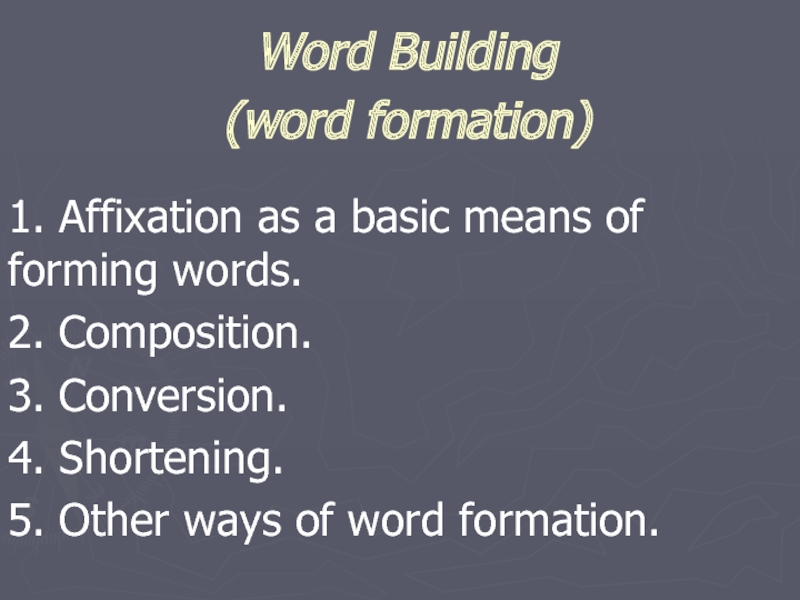
Слайд 2Scientists usually distinguish:
affixation,
composition,
conversion,
abbreviation
(shortening, clipping, acronymy),
back formation (disaffixation),
sound
interchange and distinctive change,
onomatopoeia (sound imitation).
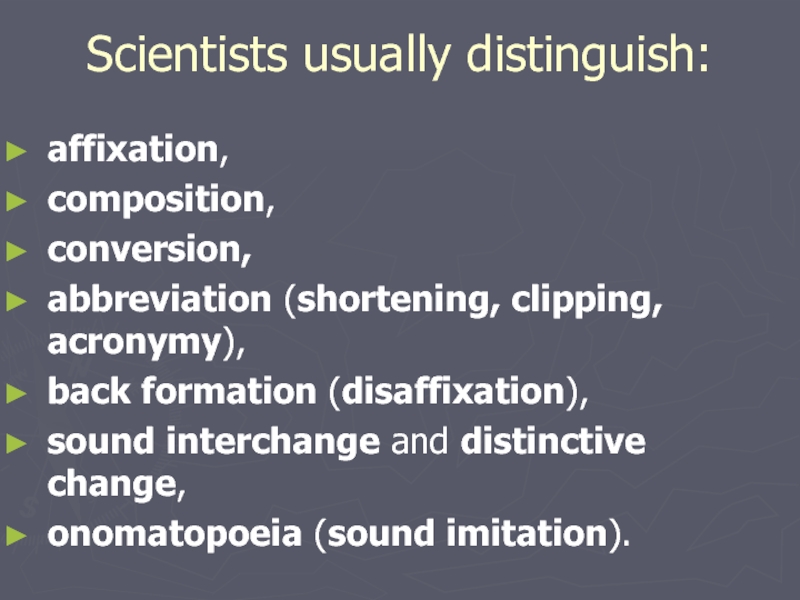
Слайд 3Affixation (the addition of an affix)
is
a basic means of forming words in
E.
A prefix is an affix attached to the front of its base.
A suffix is an affix attached to the end of its base.
An infix is a type of affix that occurs within a base of a word to express such notions as tense, number, or gender٭.
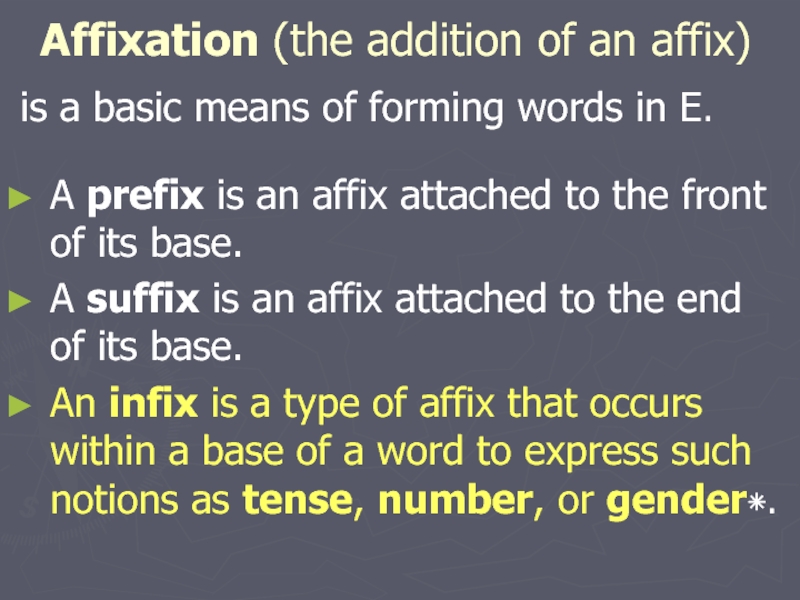
Слайд 4Affixation = suffixation + prefixation
In Modern
English, suffixation is characteristic of noun and
adjective formation, while prefixation is typical of verb formation.
Prefixes modify the lexical meaning of stems to which they are added:
usual – unusual; fit – misfit.
Suffixes don’t only modify the lexical meaning of the stem, but the word itself is usually transferred to another part of speech:
care (n) – careless (adj).
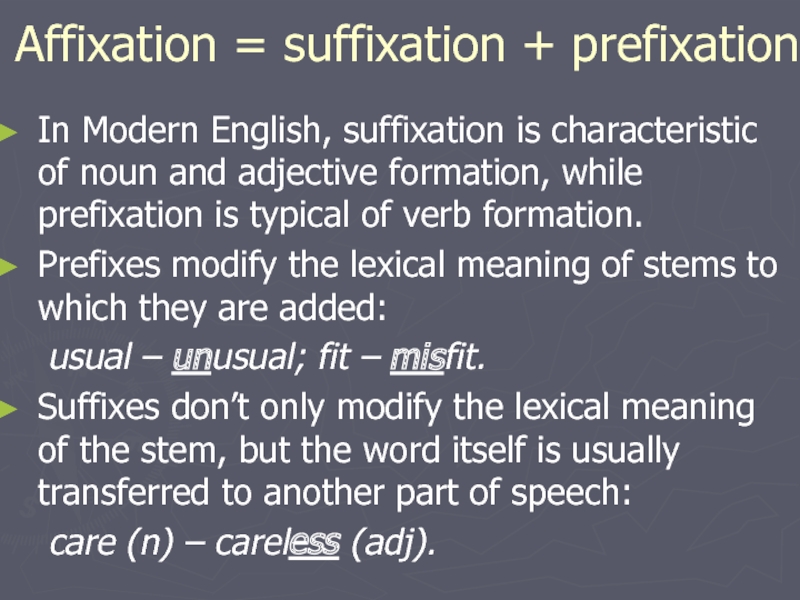
Слайд 5Suffixes and prefixes may be classified along
different lines.
The logical classification of suffixes
is according to their origin, meaning, part of speech they form, productivity.
Prefixes can be classified according to their meaning and origin.
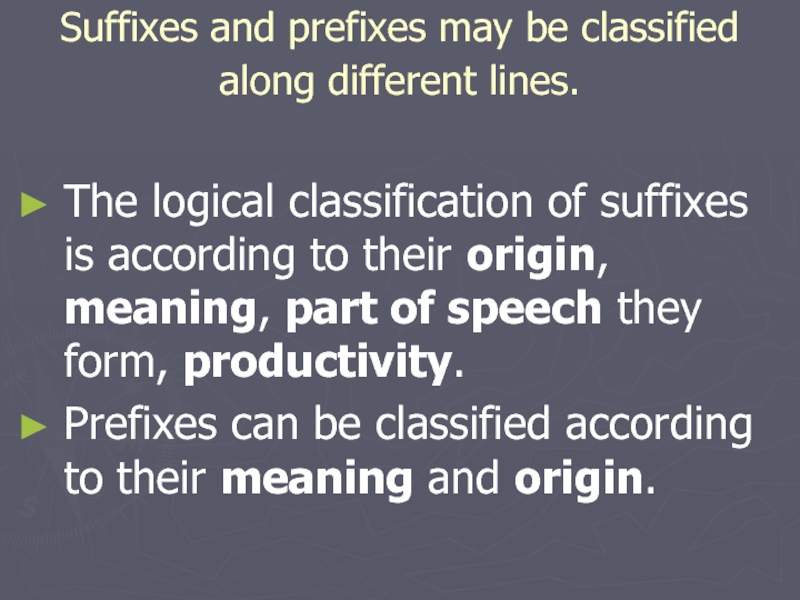
Слайд 6Suffixes
(a) their origin: Romanic (-age, -ment,
-tion), Native (-er, dom, -ship), Greek (-ism,
-ize), etc.;
(b) meaning: -er (the agent of the action), -ess (feminine gender), -ence/ance (abstract meaning), -ie and -let (diminutiveness), -age, -dom (collectivity), -an, -ese, -ian (appurtenance), etc.;
(c) part of speech they form: noun suffixes -er, -ness, -ment; adjective-forming suffixes -ish, -ful, -less, -y; verb-suffixes -en, -fy, etc.;
(d) productivity – productive suffixes are -er, -ly, -ness, -ie, -let, non-productive (-dom, -th) and semi-productive (-eer, -ward).
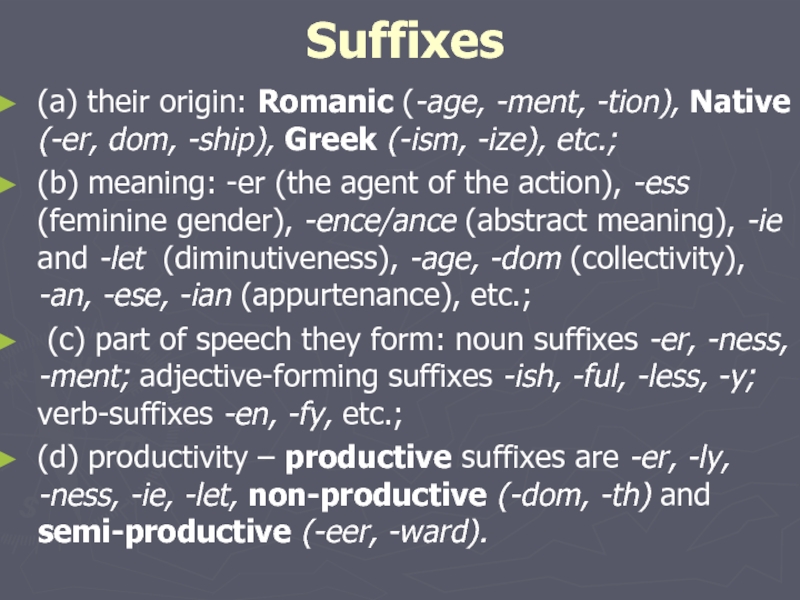
Слайд 7Prefixes
negative (unpack, non-formal, inseparable);
denoting repetition or
reversative action (decolonize, rewrite, disconnect, undo);
denoting time
(pre-election), space (interethnic) and degree relations (overwork) or
Germanic (underestimate);
Romanic (ex-wife);
Greek (hypertext).
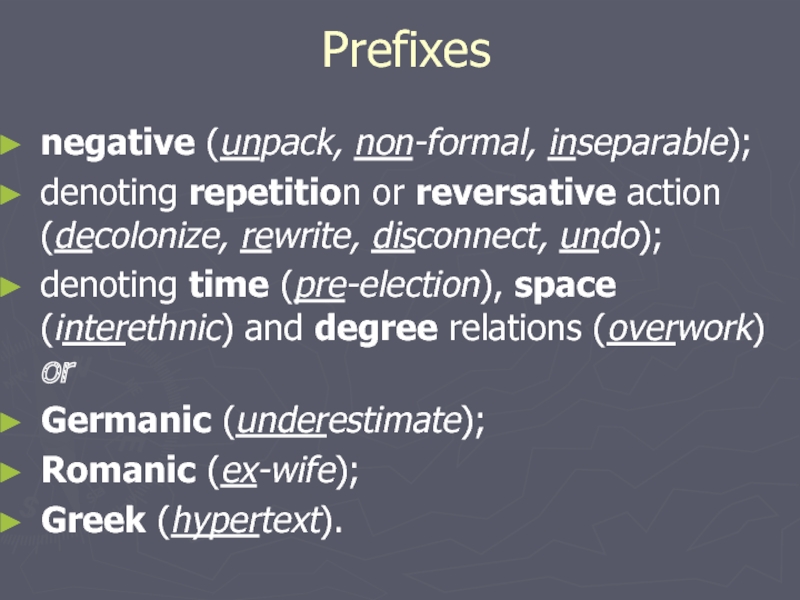
Слайд 8Some linguists distinguish between suffixes and semi-suffixes
such as -man (postman); -burger (fish-burger); -aholic
(workaholic) – either affixed words or compound words.
Some prefixes are treated as root morphemes because they are met as words: afternoon – after school; overhead – over the wall. American lexicographers treat such words as compound words, while British lexicographers regard them as affixed words. There are also semi-prefixes such as -mini (mini-plane); -maxi (maxi-taxi); -aero (aerospace); -eco (eco menu), etc.
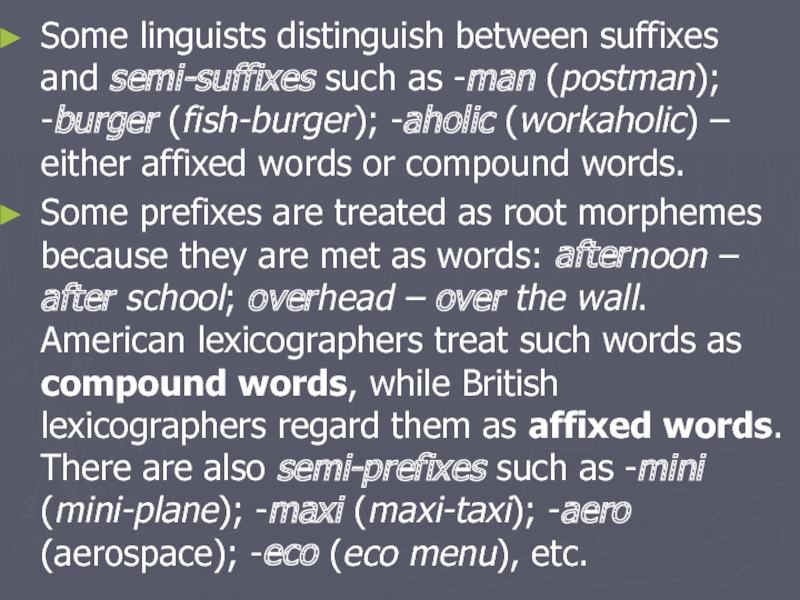
Слайд 9The main function of prefixes in English
is to change the lexical meaning of
the same part of speech. However, in ME there are prefixes that form one part of speech from another:
danger (n) → endanger (v),
head (n) → behead (v),
sleep (v) → asleep (stative).
AFFIXATION is a way of word formation consisting in adding an affix to the stem of a word: sixteen, friendship, unkindly, heartless, ex-husband, etc.
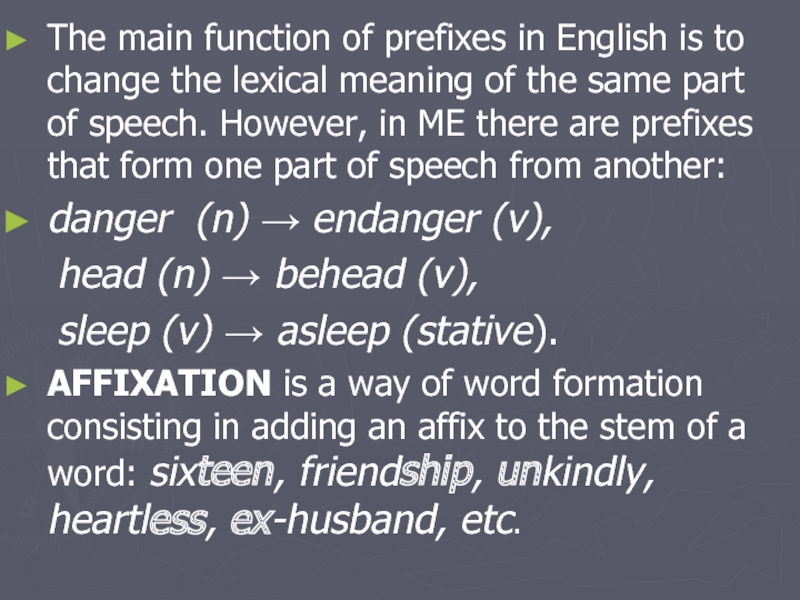
Скачать материал

Скачать материал




- Сейчас обучается 268 человек из 64 регионов


- Сейчас обучается 396 человек из 63 регионов


Описание презентации по отдельным слайдам:
-
1 слайд
Word-building in Modern English
-
2 слайд
By word-building are understood processes of producing new words from the resources of this particular language. Together with borrowing, word-building provides for enlarging and enriching the vocabulary of the language.
-
3 слайд
Morpheme is the smallest recurrent unit of language directly related to meaning
-
4 слайд
All morphemes are subdivided into two large classes: roots (or radicals) and affixes. The latter, in their turn, fall into prefixes which precede the root in the structure of the word (as in re-read, mispronounce, unwell) and suffixes which follow the root (as in teach-er, cur-able, diet-ate).
-
5 слайд
We can distinguish words due to a morphological structure
Words which consist of a root are called root words:
house, room, book, work, port, street, table, etc. -
6 слайд
We can distinguish words due to a morphological structure
Words which consist of a root and an affix (or several affixes) are called derived words or derivatives and are produced by the process of word-building known as affixation (or derivation):
re-read, mis-pronounce, un-well, teach-er. -
7 слайд
We can distinguish words due to a morphological structure
A compound word is made when two words are joined to form a new word:
dining-room, bluebell (колокольчик), mother-in-law, good-for-nothing(бездельник) -
8 слайд
We can distinguish words due to a morphological structure
Сompound-derivatives are words in which the structural integrity of the two free stems is ensured by a suffix referring to the combination as a whole, not to one of its elements:
kind-hearted, old-timer, schoolboyishness, teenager. -
9 слайд
There are the following ways of word-building:
Affixation
Composition
Conversion
Shortening (Contraction)
Non-productive types of word-building:
A) Sound-Imitation
B) Reduplication
C) Back-Formation (Reversion) -
10 слайд
Affixation
The process of affixation consists in coining a new word by adding an affix or several affixes to some root morpheme.
-
11 слайд
The role of the affix in this procedure is very important and therefore it is necessary to consider certain facts about the main types of affixes. From the etymological point of view affixes are classified into the same two large groups as words: native and borrowed.
-
-
-
-
15 слайд
An affix of foreign origin can be regarded as borrowed only after it has begun an independent and active life in the recipient language and it is taking part in the word-making processes of that language. This can only occur when the total of words with this affix is so great in the recipient language as to affect the native speakers’ subconscious to the extent that they no longer realize its foreign flavour and accept it as their own.
-
16 слайд
By productive affixes we mean the ones, which take part in deriving new words in this particular period of language development. The best way to identify productive affixes is to look for them among neologisms and so-called nonce-words.
The adjectives thinnish (жидковатый) and baldish (лысоватый) bring to mind dozens of other adjectives made with the same suffix: oldish (староватый), youngish (моложавый), mannish (мужеподобная), girlish (женоподобный), longish (длинноватый), yellowish (желтоватый), etc.The same is well illustrated by the following popular statement: «/ don’t like Sunday evenings: I feel so Mondayish». (Чу́вствующий лень по́сле воскре́сного о́тдыха)
-
17 слайд
One should not confuse the productivity of affixes with their frequency of occurrence. There are quite a number of high-frequency affixes which, nevertheless, are no longer used in word-derivation
e. g. the adjective-forming native suffixes -ful, -ly; the adjective-forming suffixes of Latin origin -ant, -ent, -al which are quite frequent
-
-
19 слайд
Some Non-Productive Affixes
-
20 слайд
Composition
Composition is a type of word-building, in which new words are produced by combining two or more stems
-
21 слайд
Compounds are not homogeneous in structure. Traditionally three types are distinguished:
neutral
morphological
syntactic -
22 слайд
Neutral
In neutral compounds the process of compounding is realised without any linking elements, by a mere juxtaposition of two stems, as in
blackbird(дрозд)
shopwindow(витрина) sunflower(подсолнух) bedroom(спальня) etc. -
23 слайд
There are three subtypes of neutral compounds depending on the structure of the constituent stems.
The examples: shopwindow(витрина), sunflower(подсолнух), bedroom(спальня) represent the subtype which may be described as simple neutral compounds: they consist of simple affixless stems.
-
24 слайд
Compounds which have affixes in their structure are called derived or derivational compounds.
E.g. blue-eyed(голубоглазый),
broad-shouldered(широкоплечий) -
25 слайд
The third subtype of neutral compounds is called contracted compounds. These words have a shortened (contracted) stem in their structure:
V-day (день победы) (Victory day), G-man (агент ФБР) (Government man «FBI agent»), H-bag (сумочка) (handbag), T-shirt(футболка), etc. -
26 слайд
Morphological
Morphological compounds are few in number. This type is non-productive. It is represented by words in which two compounding stems are combined by a linking vowel or consonant:
e. g. Anglo-Saxon, Franko-Prussian, handiwork(изделие ручной работы), statesman (политический деятель/политик) -
27 слайд
Syntactic
These words are formed from segments of speech, preserving in their structure numerous traces of syntagmatic relations typical of speech: articles, prepositions, adverbs.
e.g. father-in-law, mother-in-law etc. -
28 слайд
Conversion
Conversion consists in making a new word from some existing word by changing the category of a part of speech, the morphemic shape of the original word remaining unchanged.
-
29 слайд
It has also a new paradigm peculiar to its new category as a part of speech. Conversion is a convenient and «easy» way of enriching the vocabulary with new words. The two categories of parts of speech especially affected by conversion are nouns and verbs.
-
30 слайд
Verbs made from nouns are the most numerous amongst the words produced by conversion:
e. g. to hand(передавать)
to back(поддерживать)
to face(стоять лицом к кому-либо)
to eye(рассматривать)
to nose(разнюхивать)
to dog(выслеживать) -
31 слайд
Nouns are frequently made from verbs:
e.g. make(марка)
run(бег)
find(находка)
walk(прогулка)
worry(тревога)
show(демонстрация)
move(движение) -
32 слайд
Verbs can also be made from adjectives:
e. g. to pale(побледнеть)
to yellow(желтеть)
to cool(охлаждать)Other parts of speech are not entirely unsusceptible to conversion.
-
33 слайд
Shortening (Contraction)
This comparatively new way of word-building has achieved a high degree of productivity nowadays, especially in American English.
Shortenings (or contracted words) are produced in two different ways. -
34 слайд
The first way
The first is to make a new word from a syllable (rarer, two) of the original word.
The latter may lose its beginning (as in phone made from telephone, fence from defence), its ending (as in hols from holidays, vac from vacation, props from properties, ad from advertisement) or both the beginning and ending (as in flu from influenza, fridge from refrigerator) -
35 слайд
The second way
The second way of shortening is to make a new word from the initial letters of a word group:
U.N.O. from the United Nations Organisation, B.B.C. from the British Broadcasting Corporation, M.P. from Member of Parliament. This type is called initial shortenings. -
36 слайд
Both types of shortenings are characteristic of informal speech in general and of uncultivated speech particularly:
E. g. Movie (from moving-picture), gent (from gentleman), specs (from spectacles), circs (from circumstances, e. g. under the circs), I. O. Y. (from I owe you), lib (from liberty), cert (from certainty), exhibish (from exhibition), posish (from position) -
37 слайд
Non-productive types of word-building
Sound-Imitation
Words coined by this interesting type of word-building are made by imitating different kinds of sounds that may be produced by
human beings: to whisper (шептать), to whistle (свистеть), to sneeze (чихать), to giggle (хихикать); -
38 слайд
animals, birds, insects: to hiss (шипеть), to buzz (жужжать), to bark (лаять), to moo (мычать);
inanimate objects: to boom (гудеть), to ding-dong (звенеть), to splash (брызгать); -
39 слайд
Reduplication
In reduplication new words are made by doubling a stem, either without any phonetic changes as in bye-bye (coll, for good-bye)
or with a variation of the root-vowel or consonant as in ping-pong, chit-chat (this second type is called gradational reduplication). -
40 слайд
This type of word-building is greatly facilitated in Modern English by the vast number of monosyllables. Stylistically speaking, most words made by reduplication represent informal groups: colloquialisms and slang. E. g. walkie-talkie («a portable radio»), riff-raff («the worthless or disreputable element of society»; «the dregs of society»), chi-chi (sl. for chic as in a chi-chi girl)
-
41 слайд
In a modern novel an angry father accuses his teenager son of doing nothing but dilly-dallying all over the town. (dilly-dallying — wasting time, doing nothing)
-
42 слайд
Another example of a word made by reduplication may be found in the following quotation from “The Importance of Being Earnest” by O. Wilde:
Lady Bracknell: I think it is high time that Mr. Bunbury made up his mind whether he was going to live or to die. This shilly-shallying with the question is absurd. (shilly-shallying — irresolution, indecision) -
43 слайд
Back-formation
Forming the allegedly original stem from a supposed derivative on the analogy of the existing pairs, i. e. the singling-out of a stem from a word which is wrongly regarded as a derivative.
-
44 слайд
The earliest examples of this type of word-building are the verb to beg (попрошайничать) that was made from the French borrowing beggar (нищий, бедняк), to burgle (незаконно проникать в помещение) from burglar (вор-домушник).
In all these cases the verb was made from the noun by subtracting what was mistakenly associated with the English suffix -er. -
45 слайд
Later examples of back-formation are to blood-transfuse (делать переливание крови) from blood-transfuing, to force-land (совершать вынужденную посадку) from forced landing, to baby-sit (присматривать за ребенком) from baby-sitter.
Найдите материал к любому уроку, указав свой предмет (категорию), класс, учебник и тему:
6 210 103 материала в базе
- Выберите категорию:
- Выберите учебник и тему
-
Выберите класс:
-
Тип материала:
-
Все материалы
-
Статьи
-
Научные работы
-
Видеоуроки
-
Презентации
-
Конспекты
-
Тесты
-
Рабочие программы
-
Другие методич. материалы
-
Найти материалы
Другие материалы
- 22.12.2020
- 161
- 0
- 21.12.2020
- 503
- 1
- 04.12.2020
- 135
- 0
- 19.11.2020
- 358
- 4
- 21.10.2020
- 267
- 0
- 15.10.2020
- 259
- 2
- 08.10.2020
- 182
- 0
- 03.09.2020
- 154
- 1
Вам будут интересны эти курсы:
-
Курс профессиональной переподготовки «Клиническая психология: организация реабилитационной работы в социальной сфере»
-
Курс повышения квалификации «Экономика и право: налоги и налогообложение»
-
Курс повышения квалификации «Организация практики студентов в соответствии с требованиями ФГОС педагогических направлений подготовки»
-
Курс профессиональной переподготовки «Логистика: теория и методика преподавания в образовательной организации»
-
Курс повышения квалификации «Маркетинг в организации как средство привлечения новых клиентов»
-
Курс повышения квалификации «Разработка бизнес-плана и анализ инвестиционных проектов»
-
Курс повышения квалификации «Основы менеджмента в туризме»
-
Курс профессиональной переподготовки «Управление ресурсами информационных технологий»
-
Курс профессиональной переподготовки «Разработка эффективной стратегии развития современного вуза»
-
Курс профессиональной переподготовки «Деятельность по хранению музейных предметов и музейных коллекций в музеях всех видов»
-
Курс профессиональной переподготовки «Риск-менеджмент организации: организация эффективной работы системы управления рисками»
-
Курс профессиональной переподготовки «Организация системы менеджмента транспортных услуг в туризме»
-
Курс повышения квалификации «Финансовые инструменты»
-
Курс повышения квалификации «Информационная этика и право»













































